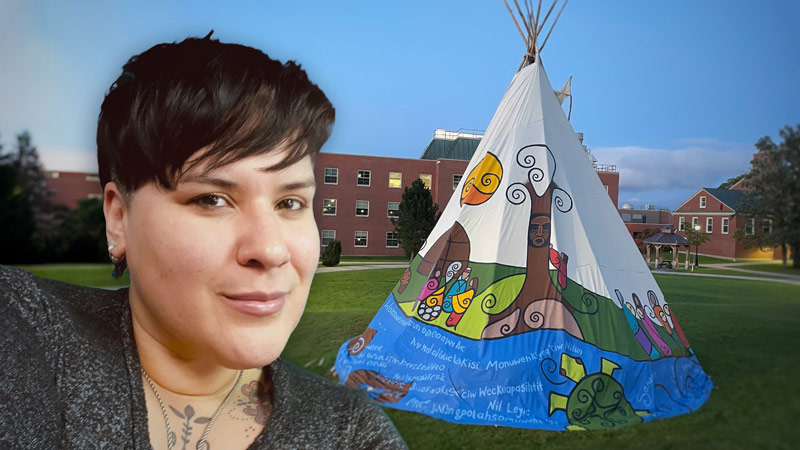Unwavering Spirit: How one Indigenous artist worked with her community to preserve Indigenous language
Author: Angie Deveau
Posted on Jun 21, 2023
Category: UNB Fredericton , UNB Saint John

In the fall of last year, folks from the Mi'kmaq-Wolastoqey Centre on the University of New Brunswick’s (UNB) Fredericton campus erected a tipi. They invited the community to attend a smudging ceremony and sacred fire to celebrate and share this space. The gatherings included meetings with Elder Jeannie Bartibogue, UNB's Knowledge Carrier-in-Residence, who shared her knowledge of smudging, sweat lodges and longhouses.
But this tipi was more than just a structure. It was a call to action and an integral part of UNB’s former Elder-In-Residence Imelda Perley’s vision to establish sacred spaces on UNB’s campus.
Elder Perley approached Wolastoqey artist Natalie Sappier with a special request in 2019. She envisioned a tipi adorned with the language that survived against the tides of time. The tipi would pay tribute to dedicated teachers who safeguarded their linguistic heritage.
Touched by this profound idea, Sappier embraced the opportunity to support Elder Perley's vision. She knew her role as an artist extended far beyond the canvas.
“When Imelda came to me with a vision of wrapping our language around a tipi to honour our language carriers, I immediately became inspired to help,” said Sappier.
To collect stories to incorporate into the tipi, Sappier attended the first Wabanaki Language Revival Gathering held at the Richard J. CURRIE CENTRE at UNB. During this gathering, she engaged with community members and provided them with large sheets of paper to write, draw and express their desires for the tipi.
As a lifelong learner, Sappier understood the importance of listening to and observing the stories shared by her community. And each tale she heard shaped her creative process. As she explored her people's experiences, struggles and triumphs, she knew her purpose was to realize this vision.
Though she may not have understood every word spoken during that gathering, Sappier felt the raw emotions and profound meanings infused into each conversation. They transported her to her childhood, evoking memories of her grandparents and a simple way of life.
“I listened and witnessed and tried to translate that through symbols, imagery and colours,” said Sappier. “The paper was covered in language and stories. If someone didn't know the word in their language, I told them to write it in English. I would find a way to translate the word for them.”
The painting process lasted approximately a month at the New Brunswick Provincial Exhibition. Sappier used high-quality, weatherproof paint and incorporated various colours to represent diversity and inclusivity. The results were impressive.
By translating the community's stories, symbols and colours into a visual language, Sappier created a piece of artwork that resonated with the heart of her people.
The tipi's design became a vessel, carrying the Wolastoq River, the sacred fire, the sweat lodge, the canoe and the wampum—a tapestry of their culture's essence. Recurring words and symbols embodied their heritage: teachers, love, grandparents, children, songs, dance, land and water.
Sappier explained that every stroke she made held profound significance.
“There’s so much symbolism,” she explained. “I always associated double curves with our clothing, basketry and canoes. I like to paint and tell stories through our motifs. It's like reviving my ancestors' sleeping teachings."
She even painted a tree with a mask to honour Ned Bear. Ned Bear was a beloved figure who safeguarded their stories and passed on his artistic knowledge. She explained that she used spirals and other symbols to echo the multi-faceted nature of her people’s identity, representing the diverse threads that interweave to create the tapestry of their culture.
The tipi, which was taken down for the winter, will be re-erected in the fall to prepare for the second Wabanaki Language Revival Gathering. Sappier reflects on the experience and hopes the tipi will create awareness and promote a sense of welcome and respect on the UNB campus. She believes art is a powerful medium for storytelling, communication and bringing people together.
“Art speaks different languages,” she said.” It creates conversation and allows us to look through a different perspective. The tipi symbolizes our collective role in healing, affecting change and giving a voice to marginalized communities.”
